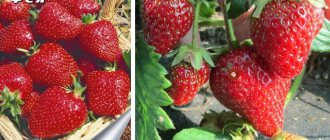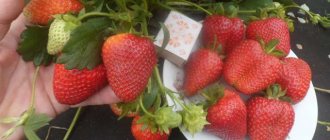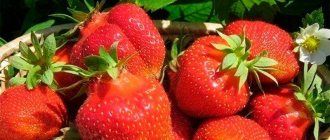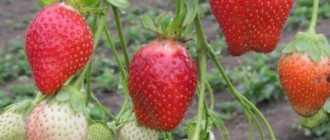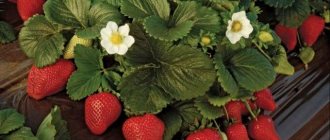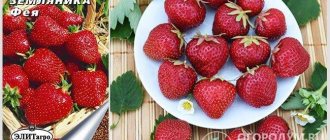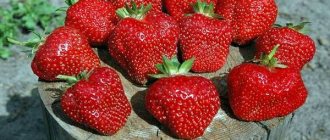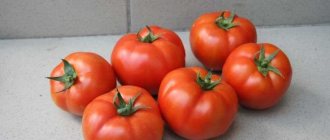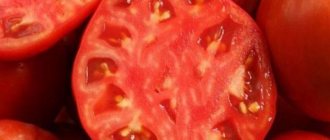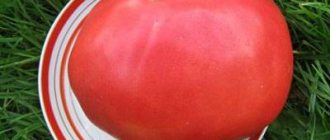Strawberry varieties bred in Europe are popular in Russia. Darselect is considered one of these varieties. The variety was bred in France and became widespread there. The French are proud of the product of their selection, as it turned out great: smooth berries with a pronounced sweet taste. Even inexperienced gardeners grow Darselect, since, judging by the reviews, caring for it is not difficult. Read on for a more detailed description.
Description of the strawberry variety Darselect
The Darselect garden strawberry was bred in 1998 by French breeders as a result of crossing the leading European varieties Parker and Elsant. Mid-early variety with short daylight hours. It has a high yield of 0.7-1.0 kg per bush. According to reviews from gardeners, the yield of Darselect strawberries can be increased to 1.2 kg. The berries retain their shape for a long time, without losing it even during transportation. After collection they do not flow or darken.
Characteristics and description of Darselect strawberries:
- large fruits – 18-25 g (without intensive fertilizing), 30-35 g (with abundant fertilizer). There are specimens reaching a weight of 50-70 g.
- The shape of the berries is oval-conical, round, sometimes blunt at the tip. By the end of the season, the fruits may become deformed, becoming corrugated, heart-shaped, accordion-shaped or comb-shaped.
- The color is brick red, with an orange tint, and shiny when fully ripe.
- The pulp is light red, dense.
- The taste is dessert, moderately sweet, with a slight sourness.
- The aroma is bright, reminiscent of wild strawberries.
- The bushes are tall, with medium foliage.
- Average number of whiskers.
- Powerful root system.
- Dark green foliage.
- Tall, upright branches.
Advice! To increase the yield of Darselect strawberries, it is recommended to remove all flower stalks in the first year. This method allows you to achieve maximum productivity next year.
History of creation
In 1998, under the French sun, in the experimental fields of the breeding company Societe Civile Darbonne, the first specimens of a new variety of short-day strawberries were obtained. To breed, experts crossed the well-known varieties “Elsanta” and “Parker”. During the work, they managed not only to preserve the varietal characteristics of the parent forms, but also to improve them, obtaining unique qualities - original taste, large fruit sizes. Today, the variety is one of the three leaders among strawberries for industrial production.
Pros and cons of the Darselect strawberry variety
Advantages of the Darseklet variety:
- large fruit;
- dessert taste qualities;
- original aroma similar to apricot, pineapple and strawberry;
- absence of excessive wateriness;
- short period of time between flowering and fruiting;
- gives a large number of whiskers for reproduction;
- heat resistance - strawberries tolerate high temperatures well, up to 40 ° C;
- high yield, after the first harvest new berries are formed;
- good keeping quality and transportability;
- Suitable for commercial cultivation.
Disadvantages of Darselect strawberries:
- reduction in the size of the berries and their deformation towards the end of fruiting;
- needs abundant watering, especially during dry periods;
- is afraid of frost; when the temperature drops to -20 °C, strawberry bushes must be covered;
- lack of moisture leads to the formation of voids inside the fruit and separation of the tail along with the pulp.
Reviews
Anna: “Since strawberries cannot bear fruit abundantly in the first year, having planted bushes of this variety on the plot, I prepared to pick off the flowers immediately after they appear. I was not mistaken. Thanks to this approach, the shoots, as well as the root system, developed better. As a result, the next season I harvested a lot of tasty and high-quality berries. There was even a surplus left, which I sold on the market.”
Alexey: “First I planted the bushes at a distance of 30 cm from each other. Although the plantings were compacted, the yield was low due to the development of fungal diseases. In the graying year, I increased the distance to 40 cm. The indicators increased significantly - by 15-20%.”
Planting and caring for garden strawberries Darselect
Darselect strawberries are grown both outdoors and indoors. In areas of unsustainable agriculture, it is best to cultivate garden strawberries under film covers or in greenhouses. Compliance with basic agrotechnical rules is the key to a good harvest of the Darselect variety.
Selection and preparation of a landing site
Darselect strawberries should be planted in open, well-lit areas, protected from drafts and strong winds. Shading of planting areas has an adverse effect on the yield. The berries grow small and sour. The sun, on the contrary, helps to increase the yield of Darselect strawberries.
The planting area should be flat, without steep slopes or elevations. The beds should be located on the southwestern side of the garden.
Important! It is not recommended to plant Darselect strawberries in lowlands, as this can lead to late ripening of the crop and the development of diseases.
The best harvest of garden strawberries can be obtained on light loamy soils enriched with organic matter. When choosing a planting site for growing Darselect strawberries, you need to pay attention to the occurrence of groundwater. Their level should not exceed 60 cm.
Preparation of planting material
The quality of planting material directly affects the survival rate and future productivity of established strawberry plantations. For planting, it is recommended to select strong seedlings with a well-developed and branched (at least 7-8 lobes) root system. The diameter of the root collar should be at least 1 cm.
Warning! On seedlings, the leaf surface should be reduced to the maximum to prevent excess transpiration during planting. Their above-ground part should have no more than 2-3 strong, young leaves.
Dipping the roots of seedlings into a special mash prevents them from drying out, promotes better adhesion of the soil, and as a result, the survival rate increases. It is prepared in a 1:1 ratio from the following components:
- peat, humus or vermicompost;
- soil (chernozem or clay).
Landing rules
Darselect strawberries planted in autumn take root best. The most favorable period for planting is mid-late August and early September. This time is characterized by a decrease in temperature, due to which strawberry seedlings take root without stress, having time to take root before the onset of cold weather. Gardeners use 2 types of planting - in rows and in a checkerboard pattern.
Step-by-step process of planting Darselect strawberries:
- Dig up the beds, adding humus and sand (1 bucket per 1 m2).
- Make holes about 15 cm deep.
- Pour about 1 liter of water into each well.
- Arrange the bushes.
- Gently straighten the root system. Long roots should be shortened to 10 cm.
- Cover the root system with soil without deepening the growth bud. It is important to ensure that the root collar is at soil level.
- Press down the soil around the seedlings with your hands.
- Add 1 liter of water under each bush and mulch.
Planting pattern:
Advice! You should definitely water Darselect strawberry seedlings during the rooting period.
Watering and fertilizing
Strawberry Darskeleton needs regular watering, which should be done at least 2-3 times a week. Lack of moisture can negatively affect the yield, and sometimes even lead to the complete death of strawberries. Excess moisture can also be destructive, so first of all you should focus on the condition of the soil.
Attention! At ambient temperatures above + 30 °C, Darseklet strawberries require drip irrigation.
In extreme heat, when the temperature rises above + 40 ° C, strawberry bushes must be shaded with reflective film or a special mesh.
During the flowering and fruiting period, Darselect strawberries need to be fertilized with mineral fertilizers. During the season it is recommended to feed it 3 times:
- In the spring. Strawberries need growth stimulation. Fertilizing is carried out immediately after the snow melts.
- In summer. Plants need restoration. Flower stalks are also being laid for next year. Fertilizing begins after the main harvest is harvested. It is recommended to carry out 2 feedings at intervals of 2 weeks.
- In autumn. Young seedlings require a supply of nutrients to prepare for winter. September is the optimal time for feeding.
Types of fertilizing (per 10 liters of water):
| Spring | Summer | Autumn |
| 1 tbsp. l nitromofoski | 2 tbsp. l nitromophoska, 1 tsp potassium sulfate | 1 liter mullein, 1 tbsp. ash, 2 tbsp. l superphosphate |
| 1 tbsp. l ammonium sulfate, 2 tbsp. mullein | 2 tbsp. l saltpeter | 1 tbsp. wood ash, 30 g magnesium sulfate, 2 tbsp. l nitroammofoski |
| 1 tsp boric acid, 30 drops of iodine, 1 tbsp. ash | 1 tbsp. wood ash | 1 liter mullein, ½ tbsp. ash |
Mulching and loosening
When planting, strawberry bushes can be mulched with black film. You can also use organic materials as mulch, such as hay, chopped straw, and sawdust. In this case, the planting areas are mulched at the beginning of flowering, after removing weeds and loosening the soil.
Preparing for winter
In August-September, Darselect strawberries begin to lay buds for the future harvest. During this period, the daylight hours gradually decrease and the temperature decreases. Strawberry beds need pre-winter preparation, which includes:
- Cutting off all foliage on bushes. Conducted in late autumn.
- Covering bare strawberries with dry leaves, hay, straw or special material.
Harvesting
When growing Darseklet strawberries in open ground, fruiting occurs in the first half of June, approximately June 10-15. Under film cover, the harvest begins a little earlier, approximately in mid-to-late May.
Attention! The greatest yield is produced by 2-3-year-old strawberry bushes, then the yield declines. It is recommended to renew strawberry plantations in 4-5 years.
On average, the period of intensive harvesting lasts 10-14 days. Harvesting Darselect strawberries is quite easy, since the stem of the berries is soft. Within 1 hour you can collect about 18-25 kg of berries.
Main characteristics
We will look at consumer qualities and cultivation features in detail in the article, and let’s start with the main characteristics:
| Parameter | Characteristic |
| Culture | Strawberry (Fragaria ananassa) |
| Ripening time | Early or mid-early |
| Fruiting | One-time (non-repairable) |
| Photoperiodic type | Short daylight hours |
| Productivity | High: up to 0.7-0.9 kg per bush in open ground |
| Mass of berries | In the first collections up to 50 g, on average - 20 g |
| Fruit shape | Regular cone-shaped (with a blunt apex) |
| Berry color | Brick red (with a bright scarlet tint), with a glossy sheen (matte under certain conditions) |
| Pulp | Red (lighter), juicy, dense, flavorful |
| Tasting assessment | 4.9 points (out of 5) |
| Purpose | Dessert and universal |
| Educational ability | Moderate |
| Sustainability | The variety is winter-hardy, drought-resistant; tolerant to root rot and late blight, moderately susceptible to verticellosis and powdery mildew; sensitive to brown spot and spider mites |
| Productive life cycle | It is recommended to update the plantings after 3 years |
| Registration in the State Register of the Russian Federation | Turned off |
Reproduction
Darselect strawberries can be propagated in several ways:
- Growing seeds is a rather complex and painstaking process, especially for beginners.
- Dividing the root. Select several root shoots with a powerful root system and divide them into parts.
- Sockets. The tendrils are rooted by bending them close to the ground, fixed with wire or sprinkled with soil. You should choose powerful plants 1-2 years old as a mother bush.
- Seedlings purchased from specialized nurseries.
Breeding Features
Since “Darselect” is a varietal representative of strawberries, it is propagated by vegetative methods. The most common techniques: dividing the bush with rosettes. In the first case, the procedure is carried out in the fall, when the optimal time for planting seedlings occurs.
Sequence of actions when propagating by dividing the bush:
- Remove a healthy bush from the soil, carefully free the roots from the soil so as not to damage it. If there are diseased areas, they are cut off to healthy tissue.
- Using pruners, divide the specimen and divisions so that each has 2-3 developed shoots and its own root system.
- Place in pre-prepared holes with fertile substrate, sprinkle with soil, water and mulch the soil in tree trunk circles.
When choosing an establishment with rosettes, they begin to prepare planting material in the summer. The antennae at the site of rosette formation are pressed close to the soil. They use wire to secure the fixation, but you can simply sprinkle it with soil.
When the tendrils take root, they are transplanted to a permanent place. To increase the effectiveness of the method, it is worth placing 2-3 sockets in one hole
Diseases and pests
The Darselect variety is quite resistant to diseases and pests, but sometimes strawberry bushes are affected by:
- powdery mildew;
- gray mold;
- late blight.
Significant harm to Darselect strawberries, including wilting and death, can be caused by:
- spider and strawberry mites;
- aphid;
- wasps.
Attention! It is necessary to inspect Darselect strawberry bushes daily, especially in summer. This will allow timely identification of pests or signs of disease.
To protect against diseases and pests, you can use specialized solutions or infusions prepared independently. You can spray Darselect strawberry bushes with 3% Bordeaux mixture, previously diluted with water in a 1:1 ratio. This solution protects well from diseases and repels pests - 2 g of boric acid per 10 liters of water.
